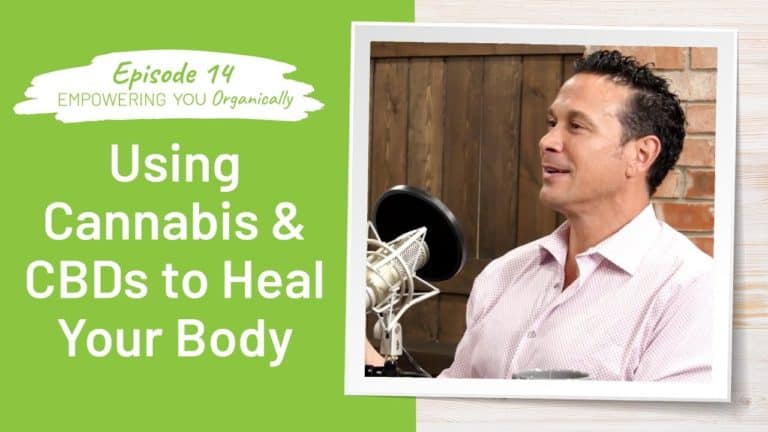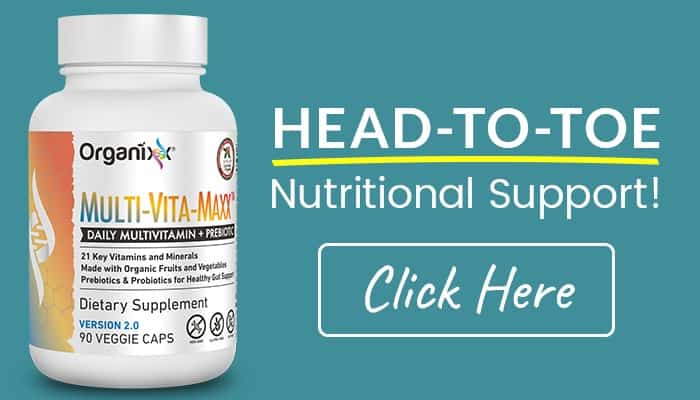Empowering you Organically – Season 2 – Episode 14
Title: How-To Use Cannabis and CBDs to Heal Your Body
Hosts: Jonathan Hunsaker & TeriAnn Trevenen
Guest: John Malanca
Description: In this week’s episode we dive deeper into understanding medical cannabis. Does it really cure what ails you or is this all smoke and mirrors?
*****
Fact: Tetrahydrocannabinolic acid (THCA), the raw acid form of THC, is the most abundant non-psychoactive cannabinoid found in cannabis.
What is the endocannabinoid system (ECS)?
- a biological system composed of endocannabinoids
- first discovered in the late 1980s
- promotes homeostasis at every level of biological life
- all vertebrates are known to have
- receptors have been found all over the body and interact with the major systems found within our body.
ECS is Made Up of 3 Parts
- Endocannabinoids
- Receptors in the nervous system and around the body that endocannabinoids and cannabinoids bond with
- Enzymes that help break down endocannabinoids and cannabinoids
Functions of the Endocannabinoid System
Research shows it is an overall body modulating system, doing its best to get our body to balance and keep it there.
- Memory
- Appetite
- Digestion
- Mood
- Inflammation
- Energy Storage and Metabolism
- Stress Response
- Immune Function
- Female Reproduction
- Autonomic Nervous System
- Analgesia
- Thermoregulation
- Sleep
- Physical Exercise
- May play a dual role on the regulation of tumor generation and progression
Receptors
CB1 and CB2 are the receptors in our bodies that receive neurotransmitters in various locations.
- Cannabinoid 1 Type is the neurotransmitter that binds with the CB1 receptor and Cannabinoid 2 Type is the neurotransmitter that binds with the CB2 receptor.
- Sub-classes of cannabinoids can be further distinguished based on where they are derived: Phytocannabinoids and Endocannabinoids.
Risks of Self Dosing with Recreational Cannabis
Not seeking a recommendation on dosing from a medical professional may be problematic to the individual.
- Drug to drug interactions
- Self-misdiagnosis
- Correct dosage
Cannabis and Inflammation
- THCA tinctures infused with coconut oil or grapeseed oil
- THCA is non-psychoactive until introduced to heat
- Very effective in maintaining a healthy inflammation response
Cannabis and Sleep
- D. Anderson has said, “Less than six hours, and more than nine hours of sleep is bad.”
- Often poor sleep is the root cause of issues like depression and anxiety
- Indica strain of cannabis plant is good for sleep – take one hour before bed
- L-Tryptophan is also a good option to aid sleep
Ratios
You will hear 2:1 ratio, 4:1 ratio, 8:1 ratio, 16:1 ratio. This can be CBD:THC or THC:CBD. Always ask what that first number is. Don’t be afraid to ask the question, “what is the first number?
Considerations When Using Medical Cannabis
- Avoid synthetic versions due to side effects
- Be educated before talking to your Doctor
- Use reputable dispensaries who create clean cannabis and provide test results
- May be used as preventative wellness medicine
The Sacred Plant
- John Malanca is host and advocate, alongside Founder Manny Goldman
- Provide education and insights from the Patient, Physician, Caregivers, Researchers, and more perspective and experiences with Cannabis as medicine
- Helping break down the stigmas, understand the research, and using this information to continue advocacy
United Patients Group
- Founded by John and Corinne Malanca to fill the information void surrounding medical cannabis.
- Don’t sell products – patient advocacy – strictly education and information.
- Teach local, state, international governments, as well as local, state and international medical institutions about medical cannabis.
- All courses are CME (continuing medical education) approved by the American Medical Association.
Studies:
Clinical Endocannabinoid Deficiency Reconsidered: Current Research Supports the Theory in Migraine, Fibromyalgia, Irritable Bowel, and Other Treatment-Resistant Syndromes – Medicine continues to struggle in its approaches to numerous common subjective pain syndromes that lack objective signs and remain treatment resistant. Foremost among these are migraine, fibromyalgia, and irritable bowel syndrome, disorders that may overlap in their affected populations and whose sufferers have all endured the stigma of a psychosomatic label, as well as the failure of endless pharmacotherapeutic interventions with substandard benefit.
The role of the endocannabinoid system in the regulation of endocrine function and in the control of energy balance in humans – The endocannabinoid system has been recently recognized as an important modulatory system in the function of brain, endocrine, and immune tissues. It appears to play a very important regulatory role in the secretion of hormones related to reproductive functions and response to stress.
Endocannabinoid system acts as a regulator of immune homeostasis in the gut – Study unveils a role for the endocannabinoid system in maintaining immune homeostasis in the gut/pancreas and reveals a conversation between the nervous and immune systems using distinct receptors.
The endocannabinoid system of the skin in health and disease: novel perspectives and therapeutic opportunities – Recent studies have intriguingly suggested the existence of a functional ECS in the skin and implicated it in various biological processes (e.g. proliferation, growth, differentiation, apoptosis and cytokine, mediator or hormone production of various cell types of the skin and appendages, such as the hair follicle and sebaceous gland).
Regulation of circulating endocannabinoids associated with cancer and metastases in mice and humans – The endocannabinoid system was subject to cancer-associated regulations to an extent that led to measurable changes in circulating endocannabinoid levels, emphasizing the importance of the endocannabinoid system in the pathophysiology of cancer.
Endocannabinoid and ceramide levels are altered in patients with colorectal cancer – Endocannabinoids and ceramides have demonstrated growth inhibition, cell death induction and pro-apoptotic activity in cancer research. In the present study, we describe the profiles of two major endocannabinoids, ceramides, free fatty acids and relevant metabolic enzymes in 47 pairs of human colorectal cancer tissues and adjacent non-tumor tissues.
Deranged endocannabinoid responses to hedonic eating in underweight and recently weight-restored patients with anorexia nervosa – Deranged endocannabinoid responses to hedonic eating in underweight and recently weight-restored patients with anorexia nervosa.
Gastric acid inhibitory and gastric protective effects of Cannabis and cannabinoids – Cannabis and/or cannabinoids protect the gastric mucosa against noxious challenge with non-steroidal anti-inflammatory drugs, ethanol as well as against stress-induced mucosal damage. Cannabis/cannabinoids might protect the gastric mucosa by virtue of its antisecretory, antioxidant, anti-inflammatory, and vasodilator properties.
The use of cannabinoids as anticancer agents – In conclusion there exist solid scientific evidence supporting that cannabinoids exhibit a remarkable anticancer activity in preclinical models of cancer. Since these agents also show an acceptable safety profile, clinical studies aimed at testing them as single agents or in combinational therapies are urgently needed. Results from these studies are essential to clarify whether cannabinoids (and specifically cannabinoid-based medicines) could be helpful in the fight of cancer.
* * *
Subscribe to Empowering You Organically
Never miss an episode!
APPLE PODCASTS SPOTIFY GOOGLE PODCASTS
–
Episode 14 – How-To Use Cannabis and CBDs to Heal Your Body





